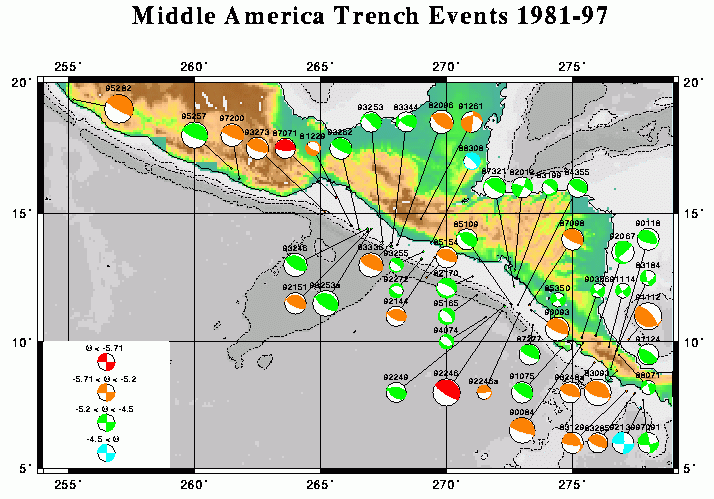Real-time determination of "Tsunami Earthquakes"
Andrew V. Newman
|
Along with Emile Okal,
I have worked to develop Real-Time Determinations of "tsunami earthquakes" from teleseismic P-waves. "Tsunami earthquakes" are
oceanic events that rupture at a significantly slower rate than do normal
tectonic earthquakes. These events are considerably more effective at
generating tsunamis (either by inducing oceanic landslides, or by setting
up a resonance effect through the water column).
Since "tsunami earthquakes" rupture at a slower rate, they radiate much
less energy in the body waves (high frequency energy) than they do in surface
waves (low frequency energy).
By utilizing the deficiency in energy radiated in the body waves we have
developed a method for determining in real-time, the impending danger these
earthquakes may bring in the form of tsunami waves.
Currently this work is for stations that are between 30 and 80 degrees from
the event; future work will include local warning.
We have also been working on determining whether the slow nature of recent
tsunami earthquakes (92 Nicaragua, 94 Java, 96 Chimbote) is seen in the other
recent large oceanic events in the respective areas.
The following three figures show the locations of the three recent
"tsunami earthquakes" as well surrounding oceanic events with seismic
moments greater than 1026. The colors of the beach balls represent the
relative Energy/Moment ratio, going from low (red) to high (blue).
|
 |
The Nicaraguan Earthquake of Sept. 2, 1992 (large red beach ball)
occurred in a region of significant trench seismicity. With the exception of a
small earthquake in 1987, there are no other significantly deficient events,
however there are a large number of intermediately deficient events (shown
with orange beach balls). |
 |
The Java Earthquake of June 2, 1994 (large red beach ball) was in an
area where no other deficient earthquakes were found. All other events had
moderate to high energy; even the five aftershocks (all with normal focal
mechanism solutions) are rich in radiated energy (blue).
|
 |
Similar to the Nicaraguan event, the Chimbote Earthquake of Feb. 21, 1996 (large red
beach ball) occurred in a region where other intermediately deficient events
have occurred (orange). |
 |
I have included a figure showing the radiated energy compared to the CMT
published seismic moment. Events that are lower and more to the right are
considered to be deficient in body wave energy. Note: The Indonesian
tsunamigenic event that generated a large tsunami in Papua New Guinea shows to
be moderately deficient. More information about this earthquake and tsunami
can be found in the August 1st
and October 3rd
issues of Science News or from
USC's PNG tsunami page.
|
Current Research |
Curriculum Vitae |
Sites of interest |
Home
anewman gatech.edu | Updated:
Sun Nov 5 14:05:35 EST 2006 gatech.edu | Updated:
Sun Nov 5 14:05:35 EST 2006
|
 gatech.edu | Updated:
Sun Nov 5 14:05:35 EST 2006
gatech.edu | Updated:
Sun Nov 5 14:05:35 EST 2006
 gatech.edu | Updated:
Sun Nov 5 14:05:35 EST 2006
gatech.edu | Updated:
Sun Nov 5 14:05:35 EST 2006